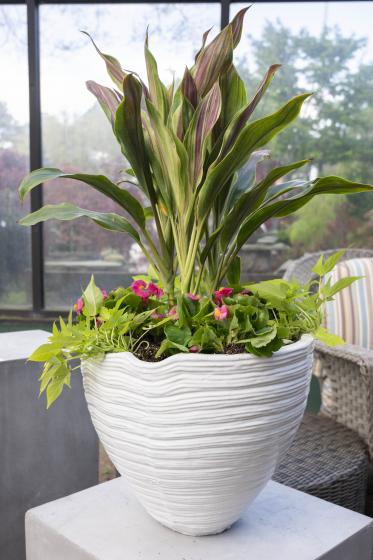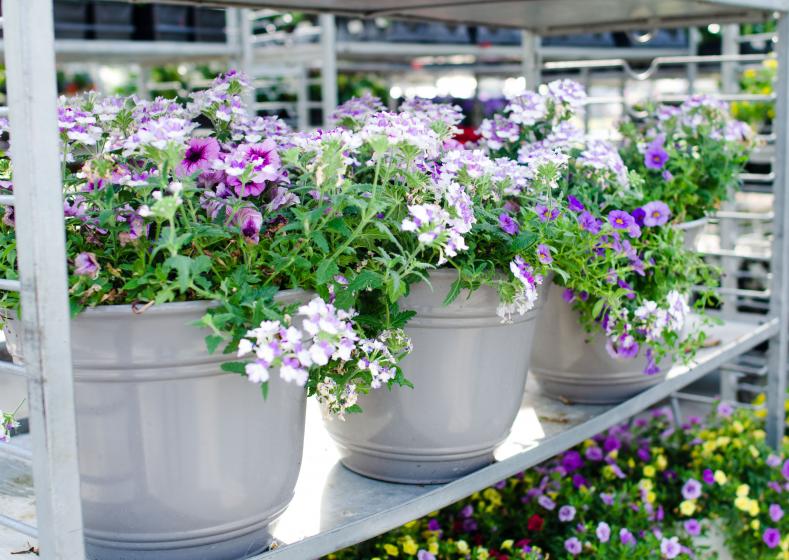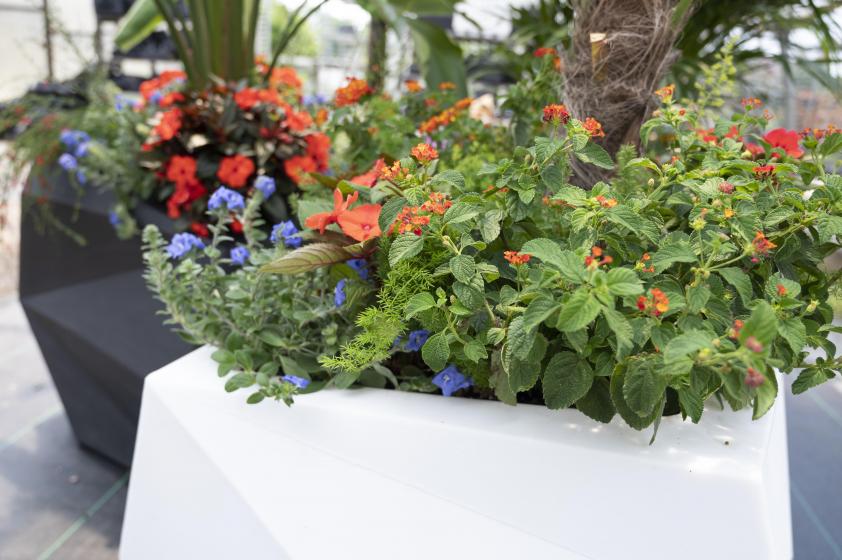Not every person has room for an extravagant garden with rows of fresh veggies, huge garden beds full of blooms, and a picturesque yard full of grasses, shrubs, and trees. Most of us have limited space, especially apartment renters and urban dwellers who only have a few feet of outdoor space. Container gardening is the pocket edition of the garden we dream of. Even gardeners that have the sprawling landscape for bed gardening, lawns, and trees still can enjoy container gardening in their homes and on the porch. Containers can provide flexibility and change to a space, indoors and outdoors, making them the most accessible way to start gardening.
WHAT CONTAINER IS BEST?
A question we hear often at McDonald Garden Center is “What container is best for my plant?” and the answer is simply: any! The three main choices are glazed ceramic, terracotta, and plastic.
- Glazed Ceramic: There are so many different options when it comes to color, size, and shape with glazed ceramic. It is a world of opportunities for both indoor and outdoor plants and usually the most long-lasting especially when choosing a frost-resistant outdoor glazed container.
- Terracotta: A beautifully orange-colored unglazed ceramic that is great for both indoor and outdoor container gardening. It is relatively inexpensive and holds moisture inside the ceramic which makes it great for dry-loving plants like cacti and succulents.
- Plastic: The most inexpensive as well as fairly indestructive, plastic is great for any container garden. Plastic pots retain moisture in the soil as water does not absorb into the pot as ceramic does. This is great for moisture-loving plants, especially if you are on a budget.
PRO TIP: Make sure the pot you pick has a hole at the bottom or a way for the water to drain out the pot. Sitting water can cause root rot in container gardens.
SIZING UP THE SITUATION
After picking the perfect pot, one of the most important things is the size of the plant(s) versus the size of the container. Plants are measured by the diameter length of the container that they are purchased in. For example, if you buy a plant in a “4-inch” pot, that is the diameter of the pot.
When purchasing new plants or when repotting old ones, you generally want to size up your new pot 2-4 inches from the pot the plant is currently in. This is dependent on the size of the plant's roots. You can check a plant's roots by either seeing the roots come out of the top of the pot, the holes at the bottom of the pot, or you can pull the plant completely out of it’s pot and see if the roots are wrapping around in a circular motion. Making sure that you don’t pot up too large or size down the pot is important to the health of the plant.
PICKING POTTING SOIL
The next step in container gardening after you have picked your pot and plant(s) is knowing what potting soil is the best for your plants. Make sure you are using potting soil or a mix that is pot-friendly. Topsoil, compost, and garden bed mixes are not meant to be used in pots. Potting soil has wetting properties that keep the plant roots moist longer than outdoor mixes would which is needed in containers.
Indoor plants may need different potting soil combinations depending on the plant's needs. For example, cacti will need a cactus mix or a well-draining soil with sand, rocks, perlite, or other draining materials while a fern might need a moisture-based mix with peat moss or all-purpose potting mix.
For outdoor plants, an all-purpose potting mix is suitable. Our McDonald Garden Center All Purpose Potting Soil comes in both regular and natural and organic for potting up outdoor plants in containers.
PRO TIP: Ask any of our Green Team members what potting soil is best for the plant you have.
THRILLER, FILLER, SPILLER
You have your plants, your pot, and your soil. It’s time to container garden! For the most extravagant outdoor containers, we recommend trying our “thriller, filler, spiller” method.
- Thriller: This will be your show stopper plant. It is usually the one with the most vibrant color or the tallest plant that you have in your container. The “notice me!” plant.
- Filler: This will be a plant that can both grow into a space quickly and add vibrant color to your container to fill up the empty space around your thriller.
- Spiller: This will be the plant that spills out over the edge of your container. Your spiller can add more contrasting color to the thriller and filler as well as extending your garden beyond its container.
FEEDING YOUR CONTAINER GARDEN
During planting, you will want to add granular plant food as you pot your plants. Some soils already have plant food in them, so make sure you are not over-feeding your plants by applying more. If your plants are already potted and you didn’t add granular plant food, don’t worry, you can also water in plant food. Water in plant foods have different ratios, so we recommend reading the labels as well as asking our Green Team members what plant food is best for your potted plants.
PRO TIP: McDonald Garden Center’s Greenleaf granular plant food can be used for both indoor and outdoor plants!
THE IMPORTANCE OF WATERING
When all is said and done and your plants are potted up, the most important thing of all for container plants is to water deeply and less often. Watering not enough can cause wilting, lackluster plants, and even root withering. Too much water can cause rot and the eventual decline of the plant. Checking your plants for dryness by using your finger, a moisture meter, or even picking up the pot (if you are able) are the best ways to make sure your plants are efficiently watered.
PRO TIP: Watering outside containers is different from watering indoor containers! Make sure you go longer between waterings indoors than outdoors, especially in the summer months when the sun is at its peak.
FINISHING TOUCHES
Once you have followed the previous steps, you have completed your beautiful container garden! Try to container garden with various plants, maybe the next project is a succulent garden or an indoor foliage terrarium for your kitchen table. The opportunities are endless! Get creative with different combinations of outdoor plants as well and don’t forget to visit McDonald Garden Center year-round locations and seasonal Markets often to change them out seasonally!




